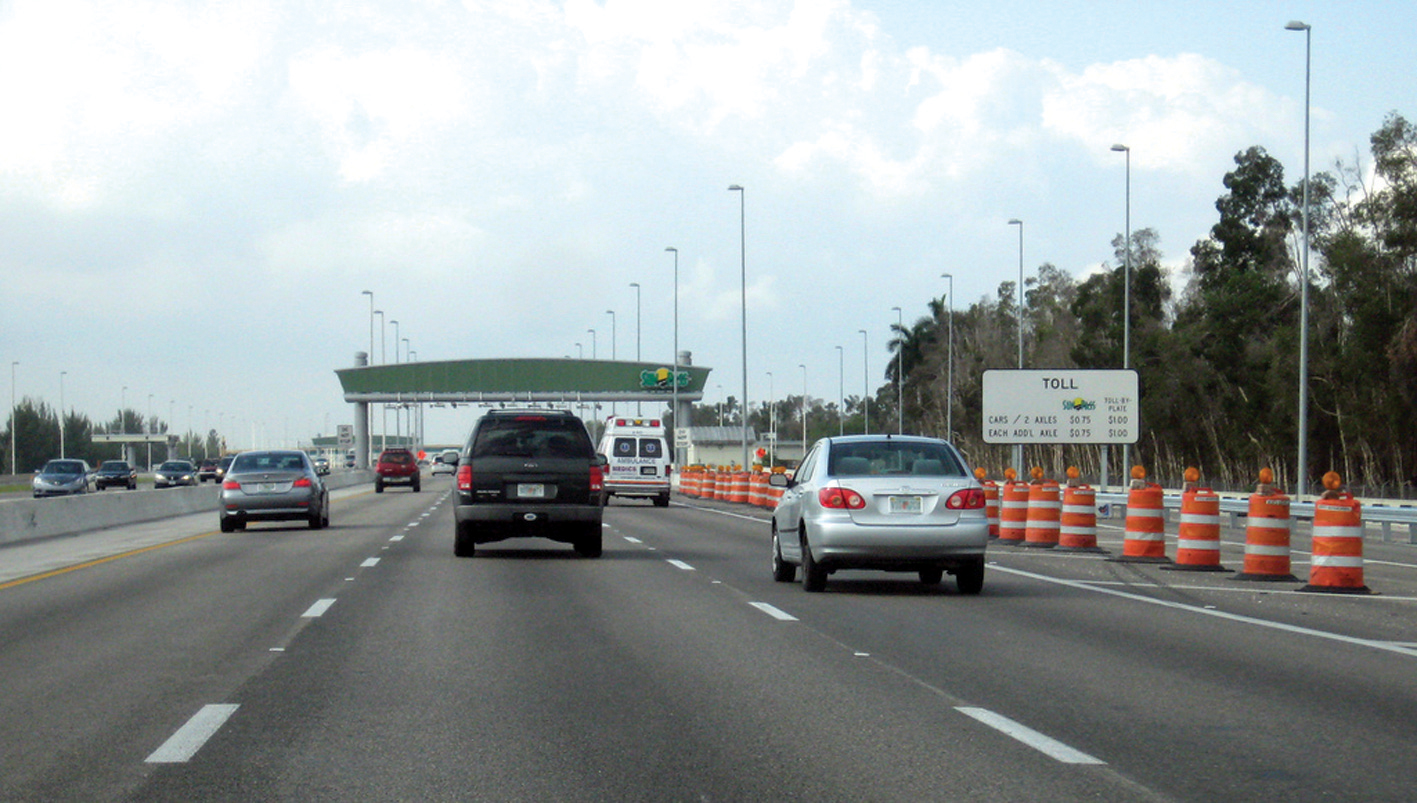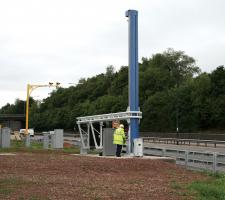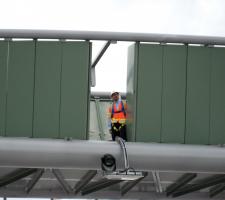
Southbound traffic approaching an FTE signature gantry at the Okeechobee tolling point at milepost 32 in Miami-Dade County (picture credit: FTE)
Maintenance of on-road ITS kit needs to become more sophisticated; while new technologies can deliver better road maintenance. David Crawford investigates both sides of the issue
"Good information is key to effective ITS asset maintenance,” says Ian Routledge of the Ian Routledge Consultancy (IRC), whose Imtrac (Information Management for TRAffic Control) system is poised for European expansion. Developed as an ‘intelligent filing cabinet’ for storing information about on-road equipment, the online database has recently moved on from a“Maintenance,” continues Routledge, “is often poorly undertaken because many public agencies have little idea of what equipment they have on-street and even less on how it is performing, eg in terms of fault rates. They seem content to deal with faults impacting on safety but are happy to live with poor operational performance.”
“Again, there is little innovative thinking on feeding back maintenance problems into design requirements for new works or modifications.” In 2011, IRC added a specific maintenance contract management capability, which, says Routledge, “will not only ensure the best use of ITS assets but deliver performance data that will allow development of new contract types.”
The result of co-director Peter Routledge’s experiences with traffic signal upgrades, Imtrac won him the young professional of the year accolade in the 2010
Access issues
Information is one key issue for ITS asset maintenance; another, notably on interurban highways, is physical access to above-the-road equipment - for traffic management or electronic fee collection – with its implications for driver and worker safety, and traffic disruption when lanes are closed. Some promising solutions are emerging.In the US, Florida’s Turnpike Enterprise (FTE), which is currently converting its entire network to all-electronic tolling, has developed its own purpose-designed overhead gantry to allow maintenance crews direct, level access from an inbuilt work platform. The idea came out of Australia, where members of the agency’s general consultant team took a detailed tour of
The agency liked the idea of having its equipment maintained from above, to remove the traffic impacts of lane closures.
It competitively selected a design proposal from Florida Structural Steel, and the resulting arched ‘signature gantry’ has been developed with a good deal of attention being paid to aesthetic considerations.
All the tolling components (antennae, cameras, illuminators, vehicle detectors and classifiers), are positioned on support arms fixed to the output shaft of a gear box bolted onto the gantry. These rotate the devices into it, with the gear box being driven by a cordless drill.
The support arms are designed and fabricated with horizontal and vertical adjustability for replacing the equipment in its correct position. There is built-in scope for handling the individual characteristics of different vendors’ products that have been researched and programmed into the system.
A full-width screen shields workers from the sight of passing motorists, to avoid their being distracted. A fine-mesh net below the work area prevents debris from falling onto the traffic below. Access is via a ladder on the inside of a support column.
For future projects
The agency has so far installed signature gantries at six locations on its network. One problem that has emerged is an 80ft (24.4m) limit in span length, any increase in which would need an intermediate column and could involve design exceptions or variations and impact on the roadway below.For future projects, therefore, FTE has developed a new, less aesthetic ‘accessible gantry’ that can bridge multiple traffic movements with a maximum span of 192ft (58.5m). Surprisingly, perhaps, the agency is not currently aware of any other US toll operators or authorities showing interest in the concept.
Another development from within the tolling sector acknowledges that one good way of reducing installation and maintenance times and costs is to rationalise the way in which equipment is being deployed. European tolling system supplier
This replaces the three that have conventionally been needed for multilane freeflow tolling. The result, says Q-Free business development manager Frank Kjelsli, is direct savings on both installation and whole-life costs.
The typical set up includes video, communications and classification systems, although there can be scope for additional components to suit operators’ needs – as part of the tolling array or independently, for example CCTV cameras – subject to gantry design and construction. In other refinements, the advanced camera system developed for use with the gantry can record live video, making it possible to tune the system remotely by reviewing the live stream.
“In other words”, says Kjelsli, “there is no need to go to the site in order to run test cases for QAing an installation towards real driving behaviour and scenarios. Tuning can happen from anywhere in the world, given data access to the system.”
Camera lenses, too, are equipped with sensors that automatically alert the control centre when they become too smeared by dirt or weather to guarantee accurate readings, allowing as-needed, rather than routine, maintenance. The Gothenburg congestion scheme in Sweden is a recent implementation.
Equipment lowering systems
With other types of on-road ITS deployment, the drive for making maintenance safer, cheaper and non-disruptive has brought in equipment lowering systems to enable roadside working. US-based innovator MG Squared, which has over 7,000 installations worldwide, most recently in Africa, has now completed its first-ever implementation within the structure of a newly-built bridge.Its system enables the unlatching of surveillance cameras and their housings, or other ITS devices, from their positions on top of poles to ground level on a stainless steel aircraft-strength cable. (The cable travels within the pole, with data and video cabling securely separated).
Alignment pins enable relatching of the equipment when it returns to its position. The portable lowering tool fits in the trunk of a small car.
As result, says company vice president Martin Maners, “surveillance camera designs need no longer be limited by location or mounting height because of maintenance considerations. A single camera mounted at 18-30 metres can do the work of three or more mounted at 12 metres or lower.”
Having an externally-mounted system to allow retrofitting, for example of bridges or communications towers, it has delivered a pioneering in-structure implementation to the Connecticut Department of Transportation (CTDOT). The location is the new Pearl Harbor Memorial Bridge in New Haven, the northbound span of which opened to traffic in 2012.
The lowering device for its PTZ camera, which needed to be strategically located to monitor traffic in all directions for incident management, is integrated, for aesthetic reasons, into the structure of a concrete pylon which serves as a bridge cable support. Only the support arm protrudes.
The camera can be winched on its cable down into the shoulder of the bridge deck, away from traffic flows, allowing maintenance by a single technician. Apart from the lowering system head and arm, the whole array had to be custom-designed to fit inside the pylon interior.
CTDOT bridge supervising engineer John S Dunham told ITS International, “As a department, we are moving toward lowering devices for many of our cameras to reduce future maintenance costs. We need special equipment - larger bucket trucks - to reach cameras above 15 metres, so we save on these.”
There will be a second installation for the bridge’s remaining span, which is still under construction. The concept, says Maners, “is definitely a goer elsewhere.”
Innovation award winner
From the other side of the Atlantic comesMounted by the side of the carriageway, it rotates to allow devices fixed to it to be lowered for maintenance or repairs. (An inbuilt safety feature ensures that the pole is fully rotated before the lowering mechanism can be driven).
Among its first major installations is a US$24.3 million scheme for the Welsh Assembly Government, which wanted to implement variable speed limit and hazard indicator signs, as well as CCTV and traffic signal equipment, on the M4 motorway in Wales.
Crown International managing director Mark Stacey claims a 15-minute on-site turnaround time for maintenance crews, and an approximate US$152,000 reduction in the overall lifetime cost of operation as compared with a fixed pole, with a design life set at 40 years. “Creating the system involved putting together a new supply chain, some of the partners in which, though possessing the technical expertise, had never undertaken a project of this scale before.
“So the risks needed to be carefully managed.” The company is currently exporting to Australia and in active discussions over future projects there; and in preliminary talks on contracts in North America and the Middle East.
On the road
Down on the road surface itself, the need for more effective maintenance strategies is attracting an encouraging array of new initiatives. The Irish National Roads Authority (NRA), for example, has funded research by transport consultancyThe agency wants to move on from a ‘worst-first’ approach, using existing condition data, to a new one based on a set of rules and algorithms for applying to road data to enable it to predict more accurately when and where maintenance will be needed. The model will also allow it to evaluate alternative environmental strategies, such as those prioritising low carbon or noise-reduction schemes, for inclusion in road maintenance programmes (RMPs).
The increasing relevance of the noise issue is being highlighted by moves such as a 2012 research call by the Paris-based Conference of European Directors of Roads. This aims to find methods of integrating strategic noise management into the operation and maintenance of national road networks “in a holistic manner”.
Reducing future road maintenance costs by encouraging innovative technological solutions is the focus of the Forum of European National Highway Research Laboratories (FEHRL)’s Forever Open Road (FOR) programme.
It sees these as being adaptable, automated and climate change-resilient, given the deployment over time of innovative construction and maintenance principles. In the ultimate scenario, they will be able to power vehicles; harvest solar energy; monitor, measure and report on their own performance and condition; and carry out some of their own maintenance.
TRL, a FEHRL member, has already investigated the feasibility of embedding self-contained wireless sensing devices into road surfaces to collect and transmit information about their condition and maintenance needs. The independent laboratory believes that all the elementary components needed to build these devices are nowadays commercially available.
It is confident that its work has already identified most of the generic requirements for these, as well as for more specific applications ranging from the simple (reading road temperatures, for instance) to the complex (such as measuring magnetic fields created by passing vehicles to assess material quality). Components researched include sensors; microprocessors; low-power radios; wireless transmitters/receivers; and energy scavenging and (taking advantage of pavement characteristics) storage arrays.
Scavenging methods
Experiments with assemblies under laboratory conditions have tested potential scavenging methods; estimated theoretical power consumption levels; and assessed signal strengths and communications ranges. TRL sees the next step as the development of a ruggedised prototype for real-life on-road testing.Meanwhile, some of its findings are being considered in the light of FEHRL’s concurrent INtelligent Renewable Optical ADvisory System (Inroads) project. This is working on the development of a new generation of flush-mounted, intelligent road studs with integrated communications enabling them to delineate traffic lanes (for example for bi-directional use, during peaks or maintenance) and monitor and communicate traffic flows.
In a similar project, TRL is trialling a scheme for mixing one specific device – the RFID tag – into asphalt mixes before these are poured. The tags will hold critical information on the location, material type and date of the application, for reading and recording by antenna-equipped scanning vehicles moving at traffic speeds.
One application would be in post-accident pavement restoration. A hand-held reader could access the necessary information on the spot, avoiding delays while engineers try to access data held in road operators’ files.
A further FOR project, Miriam (Models for rolling resistance In Road Infrastructure Asset Management), is working on optimising pavement rehabilitation strategies by specifying materials with low rolling resistance. This will be a step towards incorporating CO2 values in road asset management plans and so enabling maintenance strategies that will help to meet emissions reduction targets.
‘Virtual’ road stud solution
As an innovative support action for maintenance, Norwegian companyOne issue found with conventional LED in-road studs was that salts and exhaust gases in a submerged environment prove highly corrosive to the materials normally used.
Another was that the studded tyres used for winter driving in northern countries can quickly wear down all but the strongest of materials. But the in-road effect was still deemed necessary.
Instead of conventional road studs, the solution adopted uses flat, in-road reflectors made of a heat-treated nickel-chromium alloy - the most durable of four alternative materials tested. (Tests of alternative white stone road insets and white road marking paint proved less visually satisfactory).
The alloy ‘pads’ reflect controlled beams of yellow light, to create lines of bright spots along the road surface. These are generated by lens assemblies in the tunnel roof, fed by optical fibre cabling from laser sources in an electrical installations room, which create the correct shapes on the ground.
“The system is now a vital part of the tunnel maintenance system,” says Electronova project manager Per Kristian Lien. “Its own maintenance needs are low, as ordinary high-pressure hosing when the tunnel is routinely washed through is enough to keep it functional.
“It has been developed and engineered for this specific application. But it will work just as well in other environments that have a roof or some sort of overhead structure - particularly where traffic densities are high”.
The view from space
Sources from outer space to vehicles themselves are now being tapped for additional data that can be used for better highway management and maintenance.Road owners and operators, says the IAP’s Ian Downey, would then benefit from geological intelligence that would allow them to prioritise better-informed maintenance and risk mitigation strategies. (Other potential users include insurance companies, who need a detailed understanding of the threat of this kind of risk to their insured assets).
Live Land is supported by European transport industry end users including the Norwegian Public Road Administration, the Czech Republic Road and Motorway Directorate, and
Space assets provide the only feasible means of predicting and monitoring such hazards across large and often remote transport networks.”
Potentially useful source
Vehicles travelling on roads are another potentially useful source of information, says transport policy expert Dr John Miles, “if the vehicle manufacturers will agree to cooperate with roads engineers to make possible the use of dynamic data from on-board sensors to monitor road conditions.” Miles is co-author of the World Road Association (“Geographically-referenced information about road surface condition and friction has the potential for use for network assessment and road maintenance planning. Already, probe data from both vehicles and mobile phones is growing in importance and increasingly being used by road operators, sourced from traffic information suppliers.” Tolling, traffic management and weigh-in–motion installations could also offer important, quantified data on the location and extent of the pressures that individual sections of road pavement are experiencing. This would make it possible to specify the precise area and type of maintenance needed, reducing costs and traffic dislocation.
So could emerging connected vehicle systems. The University of Michigan Transportation Research Institute (UMTRI) has recently identified road condition monitoring as a key element in the deployment of USDOT’s Connected Vehicle Research programme, the centrepiece of its ITS Strategic Research Plan. UMTRI points out that State DOTS could usefully offer their own fleets.
WLV cost modelling
WLV aims to achieve a balance between stakeholder needs and whole-life costs by taking account of more than simply economic factors by covering sustainability and whole-life planning, and encouraging innovation. Drivers include the concept of corporate responsibility and awareness of the importance of green credentials – both of which have gained momentum in recent years, supported by national and international legislation and targets.















